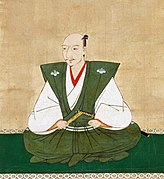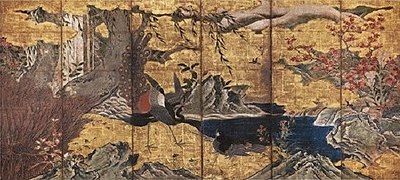Kanō Sōshū
Kanō Sōshū ( Japanese 狩 野 宗 秀 , real name: Kanō Suenobu (狩 野 季 信); born May 12, 1551 ; died 1601 ) was a Japanese painter of the Nihonga movement of the Taishō and early Shōwa periods .
life and work
Kano Sōshū was the second son of Kanō Shōei and thus the younger brother of Eitoku . When Eitoku went to Azuchi Castle in 1576 to design the walls there, Shōshū took over the family as head. Shōshū worked together with his brother, for example in 1590 when it came to the design of the imperial palace in Kyoto. In 1599 he created works for the decoration of the residence of Prince Katsura.
Sōshū was awarded the honorary title "Hōgen" (法眼) in his later years. Its style is similar to the egg focus, but is a bit coarser. It is concluded that the year of his death in 1601 was that he wrote his last will in the 11th month of the year. His son Jinnojō (狩 野 甚 之 丞; 1581 / 83-1626) continued his artistic activities, but since the same seal "Motosue" (or "Motohide" read) used, one can not always distinguish the work of father and son.
Sōshū's most famous works include the screen with the theme "Flowers and Birds" owned by the Tama family and his version of the "Thirty-six Immortals of Poetry" owned by the Toyokuni Shrine.
photos
literature
- Tazawa, Yutaka: Kanō Sōshū . In: Biographical Dictionary of Japanese Art. Kodansha International, 1981. ISBN 0-87011-488-3 .
- Laurance P. Roberts: Sōshū . In: A Dictionary of Japanese Artists. Weatherhill, 1976. ISBN 0-8348-0113-2 .
Web links
| personal data | |
|---|---|
| SURNAME | Kanō, Sōshū |
| ALTERNATIVE NAMES | 狩 野 宗 秀 (Japanese); Kanō Suenobu (real name); 狩 野 季 信 (real name, Japanese) |
| BRIEF DESCRIPTION | Japanese painter of the Nihonga school of the Taishō and early Shōwa periods |
| DATE OF BIRTH | May 12, 1551 |
| DATE OF DEATH | 1601 |



